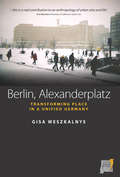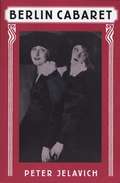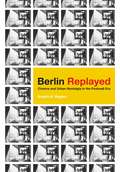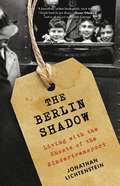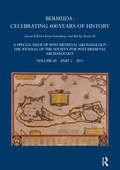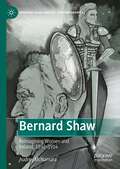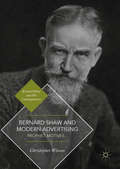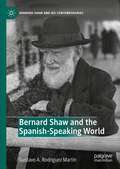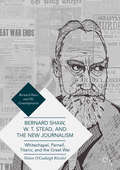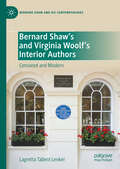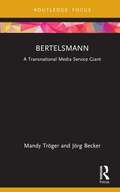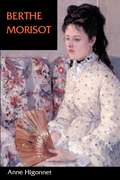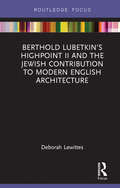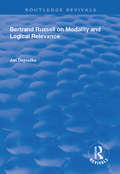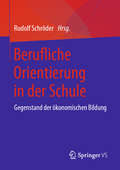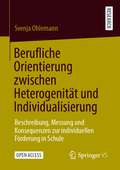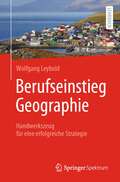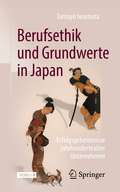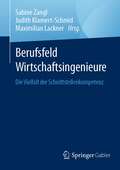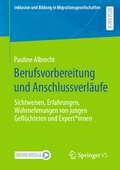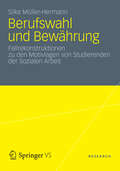- Table View
- List View
Berlin, Alexanderplatz: Transforming Place in a Unified Germany (Space and Place #1)
by Gisa WeszkalnysA benchmark study in the changing field of urban anthropology, Berlin, Alexanderplatz is an ethnographic examination of the rapid transformation of the unified Berlin. Through a captivating account of the controversy around this symbolic public square in East Berlin, the book raises acute questions about expertise, citizenship, government and belonging. Based on ethnographic fieldwork in the city administration bureaus, developers' offices, citizen groups and in Alexanderplatz itself, the author advances a richly innovative analysis of the multiplicity of place. She reveals how Alexanderplatz is assembled through the encounters between planners, citizen activists, social workers, artists and ordinary Berliners, in processes of popular participation and personal narratives, in plans, timetables, documents and files, and in the distribution of pipes, tram tracks and street lights. Alexanderplatz emerges as a socialist spatial exemplar, a 'future' under construction, an object of grievance, and a vision of robust public space. This book is both a critical contribution to the anthropology of contemporary modernity and a radical intervention in current cross-disciplinary debates on the city.
Berlin Cabaret (Studies in Cultural History)
by Peter JelavichStep into Ernst Wolzogen's Motley Theater, Max Reinhardt's Sound and Smoke, Rudolf Nelson's Chat noir, and Friedrich Hollaender's Tingel-Tangel. Enjoy Claire Waldoff's rendering of a lower-class Berliner, Kurt Tucholsky's satirical songs, and Walter Mehring's Dadaist experiments, as Peter Jelavich spotlights Berlin's cabarets from the day the curtain first went up, in 1901, until the Nazi regime brought it down. Fads and fashions, sexual mores and political ideologies--all were subject to satire and parody on the cabaret stage. This book follows the changing treatment of these themes, and the fate of cabaret itself, through the most turbulent decades of modern German history: the prosperous and optimistic Imperial age, the unstable yet culturally inventive Weimar era, and the repressive years of National Socialism. By situating cabaret within Berlin's rich landscape of popular culture and distinguishing it from vaudeville and variety theaters, spectacular revues, prurient "nude dancing," and Communist agitprop, Jelavich revises the prevailing image of this form of entertainment. Neither highly politicized, like postwar German Kabarett, nor sleazy in the way that some American and European films suggest, Berlin cabaret occupied a middle ground that let it cast an ironic eye on the goings-on of Berliners and other Germans. However, it was just this satirical attitude toward serious themes, such as politics and racism, that blinded cabaret to the strength of the radical right-wing forces that ultimately destroyed it. Jelavich concludes with the Berlin cabaret artists' final performances--as prisoners in the concentration camps at Westerbork and Theresienstadt. This book gives us a sense of what the world looked like within the cabarets of Berlin and at the same time lets us see, from a historical distance, these lost performers enacting the political, sexual, and artistic issues that made their city one of the most dynamic in Europe.
Berlin Replayed: Cinema and Urban Nostalgia in the Postwall Era
by Brigitta B. WagnerScarred by the Second World War, divided during the Cold War, and turned into a massive construction site in the early postwall years, Berlin has dramatically reinvented itself in the new millennium. Film has served a neglected but important function in this transformation.In Berlin Replayed, Brigitta B. Wagner shows how old and new films set in Berlin created a collective urban nostalgia for the city&’s best, most inclusive, and most conciliatory pasts in the face of its renewed purpose as the all-German capital. Exploring films such as Walter Ruttmann&’s Berlin: Symphony of a Great City, Wim Wenders&’s Wings of Desire, Tom Tykwer&’s Run Lola Run, and Wolfgang Becker&’s Good Bye, Lenin!, the book establishes that these films don&’t merely feature the city but actively construct how viewers come to know different Berlins of the past and present. To illustrate how film has repeatedly remade the image of the city, Berlin Replayed focuses on four key periods: the golden 1920s, when the city was a major filmmaking center; the prewall 1950s, when Berlin had two ideologically opposed film industries; the politically transformative late 1980s and early 1990s; and the hyped start of the twenty-first century.By showing how films have helped revive memories of the &“good&” Berlin and, by extension, the &“good&” Germany, Berlin Replayed reveals the underappreciated but powerful role film has played in the process of unifying Germany&’s historical experience and bridging its physical and political divisions.
The Berlin Shadow: Living with the Ghosts of the Kindertransport
by Jonathan LichtensteinA deeply moving memoir that confronts the defining trauma of the twentieth century, and its effects on a father and son. In 1939, Jonathan Lichtenstein's father Hans escaped Nazi-occupied Berlin as a child refugee on the Kindertransport. Almost every member of his family died after Kristallnacht, and, upon arriving in England to make his way in the world alone, Hans turned his back on his German Jewish culture. Growing up in post-war rural Wales where the conflict was never spoken of, Jonathan and his siblings were at a loss to understand their father's relentless drive and sometimes eccentric behavior. As Hans enters old age, he and Jonathan set out to retrace his journey back to Berlin. Written with tenderness and grace, The Berlin Shadow is a highly compelling story about time, trauma, family, and a father and son's attempt to emerge from the shadows of history.
Bermuda: Celebrating 400 Years of History
by Brent Fortenberry"This special issue ofPost-Medieval Archaeology, guest edited by Brent Fortenberry (Boston University) and Marley Brown III (The College of William and Mary), celebrates archaeology in Bermuda on the eve of the island's 400th anniversary. The volume presents the diverse nature of contemporary archaeological research on Bermuda, drawing together a wide array of scholars from the disciplines of archaeology, history, material culture studies, heritage and architectural history. The volume seeks to bring about a greater awareness of the island's archaeology and to explore its place within the historic and contemporary Atlantic world."
Bernard Shaw: Reimagining Women and Ireland, 1892–1914 (Bernard Shaw and His Contemporaries)
by Audrey McNamaraShaw emerged as a playwright in the politically charged environment of 1892, for both female suffrage and Irish independence. His plays quickly advocated for societal changes with regard to women’s roles, while expanding this advocacy into considerations of Ireland. Shaw’s engagement with marriage and union as a personal contract with nationhood have never before been considered as a methodology with which to view his work. This book demonstrates that Shaw was deeply engaged with and committed to the Irish question and to social and gender issues.
Bernard Shaw and Modern Advertising: Prophet Motives (Bernard Shaw and His Contemporaries)
by Christopher WixsonThis book charts how promotional campaigns in which Bernard Shaw participated were key crucibles within which agency and personality could re-negotiate their relationship to one another and to the consuming public. Concurrent with the rise of modern advertising, the creation of Shaw’s 'G.B.S.' public persona was achieved through masterful imitation of patent medicine marketing strategies and a shrewd understanding of the relationship between product and spokesman. Helping to enhance the visibility of his literary writing and dovetailing with his Fabian political activities, 'G.B.S.' also became a key figure in the evolution of testimonial endorsement and the professionalizing of modern advertising. The study analyzes multiple ad series in which Shaw was prominently featured that were occasions for self-promotion for both Shaw and the agencies, and presage the iconoclastic style of contemporary 'public personality' and techniques of celebrity marketing.
Bernard Shaw and the Spanish-Speaking World (Bernard Shaw and His Contemporaries)
by Gustavo A. Rodríguez MartínThis book explores, through a multidisciplinary approach, the immense influence exerted by Bernard Shaw on the Spanish-speaking world on both sides of the Atlantic. This collection of essays encompasses the reception and dissemination of his ideas; the translation of his works into Spanish; the performance history of his plays in Spain and Latin America; and Shaw’s influence on many key figures of literature in Spanish. It begins by delving into Shaw’s knowledge of Spanish literature and gauging his acquaintance with the Spanish cultural milieu throughout his tenure as an art, music, and theatre critic. His early exposure to Spanish-speaking culture later made the return trip in the form of profuse critical reception and theatrical success in countries like Spain, Argentina, Mexico, and Uruguay. This allows for a more detailed investigation into the unmistakable mark that Bernard Shaw left in the oeuvre of leading Spanish-speaking authors like Ramiro de Maeztu, Jorge Luis Borges or Nemesio Canales. This volume also assesses the translations of Shaw’s works into Spanish—while also providing a detailed publication history of these translations.
Bernard Shaw, W. T. Stead, and the New Journalism
by Nelson O'Ceallaigh RitschelThis book explores Bernard Shaw’s journalism from the mid-1880s through the Great War—a period in which Shaw contributed some of the most powerful and socially relevant journalism the western world has experienced. In approaching Shaw’s journalism, the promoter and abuser of the New Journalism, W. T. Stead, is contrasted to Shaw, as Shaw countered the sensational news copy Stead and his disciples generated. To understand Shaw’s brand of New Journalism, his responses to the popular press’ portrayals of high profile historical crises are examined, while other examples prompting Shaw’s journalism over the period are cited for depth: the 1888 Whitechapel murders, the 1890-91 O’Shea divorce scandal that fell Charles Stewart Parnell, peace crusades within militarism, the catastrophic Titanic sinking, and the Great War. Through Shaw’s journalism that undermined the popular press’ shock efforts that prevented rational thought, Shaw endeavored to promote clear thinking through the immediacy of his critical journalism. Arguably, Shaw saved the free press.
Bernard Shaw’s and Virginia Woolf’s Interior Authors: Censored and Modern (Bernard Shaw and His Contemporaries)
by Lagretta Tallent LenkerVirginia Woolf and Bernard Shaw may be the odd couple of Twentieth Century modernism. Despite their difference in age (Shaw was twenty-six years older than Woolf), and public demeanor - Shaw sought public attention while Woolf shunned the spotlight - they actively held similar convictions on most of the pressing and controversial issues of the day. This book demonstrates that both engaged in social reform through the Fabian Society; both took public anti-war positions and paid dearly for it; both fought British censorship throughout most of their careers as writers; both sought to strengthen women’s rights; and both endeavored to revolutionize their respective art forms, believing that art could bring about positive social change. The main focus of the book, however, concerns how both also created interior authors - characters who write and who either self-censor their own works or highly publicized messages or are censored by their fellow characters. These fictional authors maybe considered reflections of their creators and their respective milieus and serve to illuminate the satisfactions and torments of each famous author during the writing process.
Bertelsmann: A Transnational Media Service Giant (Global Media Giants)
by Mandy Tröger Jörg BeckerThis book analyzes one of the largest media conglomerates worldwide, the Bertelsmann Corporation. Analyzing its history, its corporate divisions and international business relations, the book focuses on the dominant role of Bertelsmann in international media – and media services – in Europe, the U.S., Latin America, and China. Addressing a broad readership interested in issues of media ownership, journalism and policy work, this book shows how issues of media ownership and corporate power are closely connected to issues of beyond media, namely politics, consulting, services and financial transactions. The book also draws parallels to other major media conglomerates and their attempts to influence communication infrastructures and policies on national and international levels, helping readers to understand the broader structural relations and power mechanisms at play in the global media market. The book will be of interest primarily to scholars in the fields of global media studies, international communication studies, and the critical political economy of media and communication.
Berthe Morisot
by Anne HigonnetOf the six Impressionist painters whose first exhibition scandalized and fascinated Paris in 1874, Berthe Morisot was the only woman. She reached a pinnacle of artistic achievement despite the restraints society placed on her sex, adroitly combining her artistic ambitions with a rewarding family life. Anne Higonnet brings fully to life an accomplished artist and her world.
Berthold Lowenfeld on Blindness and Blind People: Selected Papers
by Berthold LowenfeldThis book contains articles spanning a period of almost 40 years by Dr. Berthold Lowenfeld, a creative writer in education of the visually handicapped on Blindness and Blind People.
Berthold Lubetkin’s Highpoint II and the Jewish Contribution to Modern English Architecture
by Deborah LewittesIn 1935, the Russian-born Jewish architect Berthold Lubetkin and his firm Tecton designed Highpoint, a block of flats in London, which Le Corbusier called ‘revolutionary’. Three years later, Lubetkin completed a companion design. Yet Highpoint II felt very different, and the sense that the ideals of modernism had been abandoned seemed hard to dispute. Had modern architecture failed to take root in England? This book challenges the belief that English architecture was on hiatus during the 1930s. Using Highpoint II as a springboard, Deborah Lewittes takes us on a journey through the defining moments of modern English architecture – the ‘high points’ of the period surrounding Highpoint II. Drawing on Lubetkin’s work and his writings, the book argues that he advanced influential, lasting theories which were rooted in his design for Highpoint II. Lubetkin’s work is explored within the context of wider Jewish emigration to London during the interwar years as well as the anti-Semitism that pervaded Britain during the 1930s. As Lewittes demonstrates, this decade was anything but quiet. Providing a new perspective on twentieth-century English architecture, this book is of interest to students and scholars in architectural history, urban studies, Jewish studies, and related fields.
Bertrand Russell, Feminism, and Women Philosophers in his Circle (History of Analytic Philosophy)
by Landon D. C. Elkind Alexander Mugar KleinThis book examines Bertrand Russell’s complicated relationships to the women around him, and to feminism more generally. The essays in this volume offer scholarly reassessments of these relationships and their import for the history of feminism and of analytic philosophy.Russell is a founder of analytic philosophy. He has also been called a feminist due to his public, decades-long advocacy for women’s rights and equality of the sexes. But his private behavior towards wives and sexual partners, and his apparently dismissive (occasionally public) responses to some women philosophers, raises the question of what sort of feminist (or chauvinist) Russell actually was.Focusing on women in Russell’s circle of acquaintance, including feminist activists and his philosophical interlocutors, this book casts new light on a timeless thinker’s feminism and the women who played critical roles in the making of analytic philosophy.
Bertrand Russell on Modality and Logical Relevance (Routledge Revivals)
by Jan DejnožkaFirst published in 1999, this volume re-examines Bertrand Russell’s views on modal logic and logical relevance, arguing that Russell does in fact accommodate modality and modal logic. The author, Jan Dejnožka, draws together Russell’s comments and perspectives from throughout his canon in order to demonstrate a coherent view on logical modality and logical relevance. To achieve this, Dejnožka explores questions including whether Russell has a possible worlds logic, Rescher’s case against Russell, Russell’s three levels of modality and the motives and origins of Russell’s theory of modality.
Berufliche Bewältigungsstrategien und ,Behinderung': Undoing Disability am Beispiel hochqualifizierter Menschen mit einer Hörschädigung
by Silvester Popescu-WilligmannNormalisierungs- und Normierungspraxen der Mehrheitsgesellschaft schließen Menschen mit zugeschriebener Behinderung von der gleichberechtigten Teilhabe am Erwerbsleben aus. Silvester Popescu-Willigmann geht von einer kulturellen Genese behindernd wirkender sozialer Praktiken aus und rekonstruiert aus dieser Perspektive die Laufbahnen hochqualifizierter, beruflich erfolgreicher Menschen mit einer signifikanten Hörschädigung. Der Autor entwickelt ein Modell ihres ,,Kampfes um (berufliche) Anerkennung", in dessen Zentrum Bewältigungsstrategien stehen. Das Buch bietet Anknüpfungspunkte für weitere Forschung sowie Anregungen für Betroffene und die organisierte Selbsthilfe.
Berufliche Orientierung in der Schule: Gegenstand der ökonomischen Bildung
by Rudolf SchröderIn dem Buch wird die schulische Berufsorientierung aus fachdidaktischer Perspektive der ökonomischen Bildung erörtert. Ziel ist es, die wissenschaftliche Diskussion zur Stellung der ökonomischen Bildung in der Berufsorientierung zu intensivieren und zugleich neue Forschungsperspektiven sowie und Gestaltungsperspektiven für die Lehrerbildung und die Schulpraxis zu entwickeln.
Berufliche Orientierung zwischen Heterogenität und Individualisierung: Beschreibung, Messung und Konsequenzen zur individuellen Förderung in Schule
by Svenja OhlemannMit Blick auf die berufliche Orientierung Jugendlicher bietet dieses Open-Access-Buch eine systematische, theoriegeleitete und empirische Analyse heterogener Unterstützungsbedarfe und ihrer vielfältigen Ursachen. Die Bedeutung regelmäßiger Bedarfs- und Entwicklungsdiagnostik sowie einer systematischen Verzahnung einzelner Elemente beruflicher Orientierung im schulischen Kontext wird eindrucksvoll anhand heterogener und gleichzeitig diskontinuierlicher Entwicklungsverläufe verdeutlicht. Die Autorin weist zudem auf Konsequenzen für rahmengebende Berufsorientierungsprogramme, die Konzeption berufsorientierender Maßnahmen sowie für die Planung und Umsetzung schulinterner Konzepte hin.
Berufseinstieg Geographie: Handwerkszeug für eine erfolgreiche Strategie
by Wolfgang LeyboldWelche Berufswege stehen mir nach dem Geographiestudium offen? Was sind typisch geographische Stärken? Und wie kommuniziere ich diese erfolgreich meinem zukünftigen Arbeitgeber? Besonders für angehende Absolvierende der Geographie sind diese Fragen wichtig, da viele Arbeitgeber die Qualifikationen und die Faszination des Studienfaches Geographie nicht genau kennen. Die vielseitigen Spezialisierungsmöglichkeiten im Geographiestudium machen eine klare Kommunikation entscheidend für einen erfolgreichen Berufseinstieg. Der Autor lädt Sie auf eine spannende Reise in die mit Fragezeichen behaftete Arbeitswelt der Geographie ein: Sie entdecken angewandt und beispielhaft die unterschiedlichsten geographischen Berufsfelder. Sie erarbeiten wichtiges Handwerkszeug für Ihr Marketing in eigener Sache mit einer selbstbewussten und chancenorientierten Strategie. Zusätzlich beschäftigen Sie sich ausführlich mit Ihren Stärken, Ihrer Motivation und Ihrem Begeisterungsvermögen – mit dem Ziel, den potentiellen Arbeitgeber von Ihren Fähigkeiten zu überzeugen. Unterhaltsam geschrieben und auf beiden Perspektiven – des Geographen und des Recruitingberaters – beruhend, räumt das Buch mit der oft gestellten Frage auf: Was macht eine Geographin oder ein Geograph nach dem Studium eigentlich beruflich?
Berufsethik und Grundwerte in Japan: Erfolgsgeheimnisse jahrhundertealter Unternehmen
by Tamayo IwamuraDieses Buch untersucht an Fallbeispielen jahrhundertealter Familienbetriebe in Japan, welche Bedingungen und besonderen Grundwerte ihren betrieblichen Fortbestand fördern. Wenig überraschend finden sich diese goldenen Regeln und Maximen auch in der Arbeitskultur und Wertorientierung der führenden japanischen Großunternehmen wieder. Die Autorin beleuchtet die sozioökonomische Entwicklung im Zusammenhang mit der religiösen Tradition und bringt westlichen Lesern die oft als geheimnisvoll empfundene Kultur Japans nah. Über fundierte Kenntnisse der Grundwerte und sozioökonomischen Geschichte Japans hinaus vermittelt sie dem Leser ein echtes Verstehen japanischen Denkens und Handelns, das ihm im Umgang mit japanischen Gesprächspartnern und bei Besuchen im Land einen authentischen eigenen Handlungsspielraum bietet. Aufgrund der Corona-Pandemie befinden sich weltweit viele Betriebe in der Existenzkrise. Gerade zu diesem Zeitpunkt können die Erfahrungen jahrhundertealter Betriebe in Japan, die stets erfolgreich um ihren Fortbestand erfolgreich gekämpft haben, gute Anregungen bieten.
Berufsfeld Wirtschaftsingenieure: Die Vielfalt der Schnittstellenkompetenz
by Sabine Zangl Judith Klamert-Schmid Maximilian LacknerWirtschaftsingenieure sind Generalisten, die an der Schnittstelle Technik/Wirtschaft in unterschiedlichsten Funktionen, Projekten und Organisationen tätig sind und über ein breites Spektrum an unterschiedlicher Kompetenzen verfügen müssen. Mittels wissenschaftlicher Methoden und praxisorientieren Wissen gelingt es ihnen Prozesse zu optimieren, Innovationen zu entwickeln und Probleme zu lösen. Dieses Buch stellt typische Themenbereiche des Berufsfeldes, anhand Bachelor- und Masterarbeitsergebnisse vor und gibt somit Personalverantwortlichen und Interessenten des Berufsfeldes eine Möglichkeit in die Vielfalt der Schnittstellenkompetenz von Wirtschaftsingenieuren einzutauchen. Das Werk ist thematisch geclustert.
Berufsorientierung Jugendlicher in Deutschland: Erwartungen, Sorgen und Bedarfe (SINUS-Studien)
by Christoph Schleer Marc CalmbachWie gut sehen sich Jugendliche auf die berufliche Zukunft vorbereitet? Welche Sorgen machen sie sich? Welche Vorstellungen haben Jugendliche über die Arbeitswelt? Welche Erwartungen richten sie an Beruf und Unternehmen? Wie informieren sie sich über berufliche Optionen und wo haben sie noch Unterstützungsbedarf? Diesen und weiteren Fragen ist das SINUS-Institut mit einer repräsentativen Studie auf den Grund gegangen.Ein zentraler Befund ist, dass die Berufsentscheidung weniger durch „externe“ Faktoren erschwert wird (Noten-Defizite, Druck der Eltern, fehlende Unterstützung), sondern primär auf persönliche Unsicherheiten zurückzuführen ist. Zugespitzt formuliert beschäftigt die Jugendlichen vor allem die folgende Frage: Was will und kann ich eigentlich, und zu welchen Berufen passt das?Auf Basis der Studienergebnisse werden Schlussfolgerungen gezogen und Handlungsempfehlungen formuliert.
Berufsvorbereitung und Anschlussverläufe: Sichtweisen, Erfahrungen, Wahrnehmungen von jungen Geflüchteten und Expert*innen (Inklusion und Bildung in Migrationsgesellschaften)
by Pauline AlbrechtPauline Albrecht untersucht in ihrer Studie den Übergang junger Geflüchteter in den Arbeitsmarkt und verknüpft hiermit die Berufsbildungs- mit der Migrationsforschung. Am Forschungsstil der Grounded Theory orientiert werden Bildungs- und Erwerbsbiografien junger Menschen, die das Berliner Übergangssystem durchlaufen haben, rekonstruiert. Ausgehend von berufsvorbereitenden Angeboten werden Anschlussverläufe von geflüchteten Jugendlichen erforscht. Die subjektive Perspektive der jungen Fluchtmigrant*innen zeigt differenzierte Wahrnehmungs- und Umgangsweisen in der Auseinandersetzung mit dem Bildungs- und Ausbildungssystem, wohingegen die institutionelle Perspektive der pädagogischen Fachkräfte unterschiedliche Anforderungen an die jungen Menschen heranträgt und somit systemische Bedingungen der Berufsvorbereitung aufrechterhält. Die Frage, wie sich Anschlussverläufe aus der Berufsvorbereitung entwickeln, wird hinsichtlich einer Perspektivengegenüberstellung aufgegriffen. Zum Teil zeigen sich hier Überschneidungen sowie positive Passungsverhältnisse, jedoch auch Gegensätzlichkeiten und Widersprüche. Die Studie schließt eine erziehungswissenschaftliche Forschungslücke hinsichtlich des Übergangs junger Menschen mit Fluchthintergrund in den ersten Arbeitsmarkt.
Berufswahl und Bewährung: Fallrekonstruktionen zu den Motivlagen von Studierenden der Sozialen Arbeit
by Silke Müller HermannSilke Müller-Hermann geht der Frage nach, über welche Motivlagen Personen verfügen, die sich für einen Beruf der Sozialen Arbeit entscheiden. Hintergrund des Erkenntnisinteresses ist die professionstheoretisch begründete Einschätzung, dass es sich bei der Sozialen Arbeit um eine höchst anspruchsvolle Tätigkeit handelt, die zugleich weder mit einem herausragenden Berufsprestige, noch mit einer hohen monetären Entlohnung verbunden ist. Die Autorin zeigt anhand von Fallrekonstruktionen auf der Basis vielfältigen Datenmaterials, welche bewussten und unbewussten Erwartungen, Hoffnungen und Ansprüche mit der beruflichen Tätigkeit verbunden werden und inwiefern diese biographisch begründet sind. Aus einer religionssoziologischen Perspektive wird der Zusammenhang zwischen Berufswahl und (struktureller) Religiosität beleuchtet.
